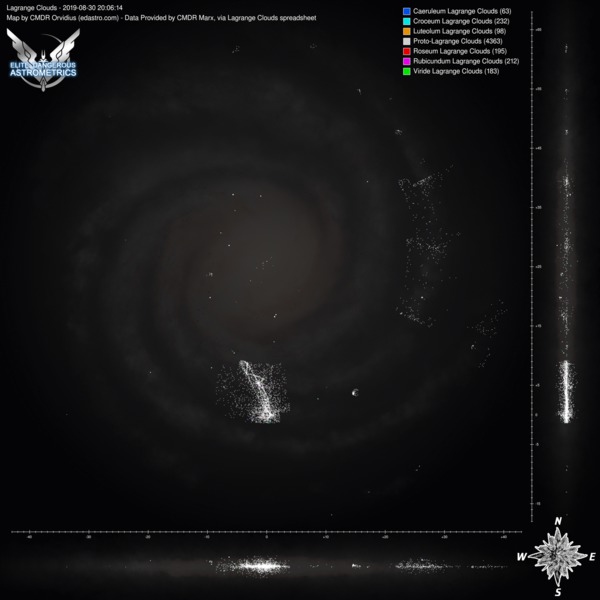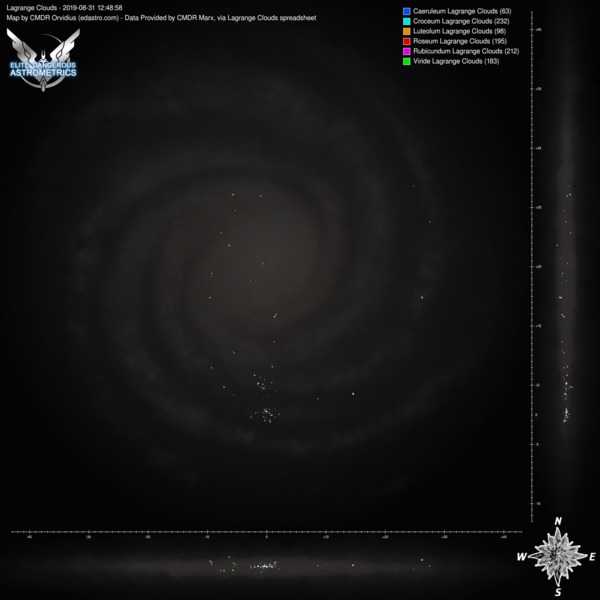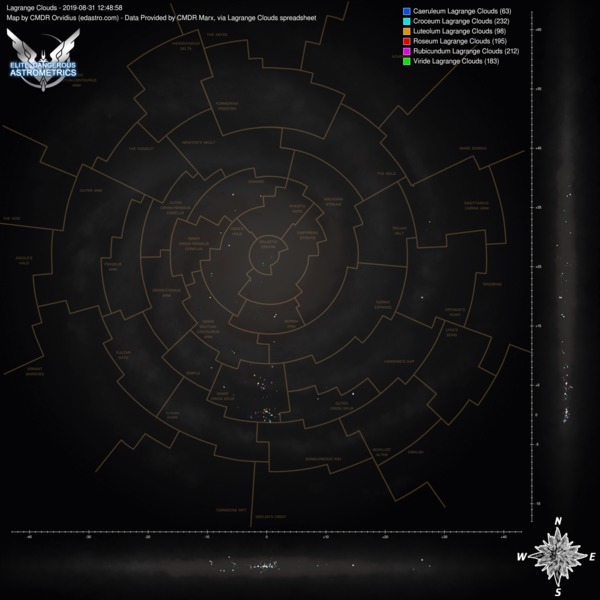Originally posted here and here, but I think it would be beneficial to have a separate thread, for easier reference and discussion.
So, from the EDSM data, I collected a list of the systems with Lagrange clouds, and Orvidius used his EDAstro stuff to map them over the Milky Way. Note that unlike almost all of his stuff there, this list isn't auto-updating: since EDSM offers no data dump or API calls to the Codex (yet?), it has to be done manually.
Some abbreviations used here: NSP: Notable Stellar Phenomena, IOS: Inner Orion Spur (the bubble's regions), PLC: Proto-Lagrange Cloud.
Lagrange Clouds spawn as containers for spaceborne life; there are no empty ones. So, they are great for getting a look at the galactic distribution of NSPs, as one doesn't have to map all the mollusc, crystal and other variations, just the clouds can be mapped. PLCs are the dominant containers, the other colourful clouds are around nebulae only. (Including inside planetary ones.)
With all that in mind, here are maps with and without PLCs, with and without region borders:




As you can see, many NSPs line up with region borders perfectly, and the vast majority of them are in the IOS. The Sagittarius-Carina Arm and Dryman's Point regions do have noticeably more, and to a lesser extent, Tenebrae as well. Otherwise, there's barely anything out there. The Sol-Colonia line (and DW2's route) gets cut off immediately after the IOS, so it's not like the bubble region has by far the most NSPs because it sees the most traffic.
This harsh drop outside the IOS has been reported to Frontier as a bug well before, but we don't know if it's intentional and will stay this way, or not.
Put another way: of the roughly 4,400 PLCs over the galaxy, 3,700 are in the IOS.
Even around nebulae, colourful Lagrange clouds are rare, and often only a couple of nebulae per region have them. Compare the non-PLC map above with this nebula map:

Another interesting statistic: Lagrange storm clouds are extremely rare. Only 11 have been found to date, compared to the 18 green gas giants.
Finally, the system data can be found here.
So, from the EDSM data, I collected a list of the systems with Lagrange clouds, and Orvidius used his EDAstro stuff to map them over the Milky Way. Note that unlike almost all of his stuff there, this list isn't auto-updating: since EDSM offers no data dump or API calls to the Codex (yet?), it has to be done manually.
Some abbreviations used here: NSP: Notable Stellar Phenomena, IOS: Inner Orion Spur (the bubble's regions), PLC: Proto-Lagrange Cloud.
Lagrange Clouds spawn as containers for spaceborne life; there are no empty ones. So, they are great for getting a look at the galactic distribution of NSPs, as one doesn't have to map all the mollusc, crystal and other variations, just the clouds can be mapped. PLCs are the dominant containers, the other colourful clouds are around nebulae only. (Including inside planetary ones.)
With all that in mind, here are maps with and without PLCs, with and without region borders:




As you can see, many NSPs line up with region borders perfectly, and the vast majority of them are in the IOS. The Sagittarius-Carina Arm and Dryman's Point regions do have noticeably more, and to a lesser extent, Tenebrae as well. Otherwise, there's barely anything out there. The Sol-Colonia line (and DW2's route) gets cut off immediately after the IOS, so it's not like the bubble region has by far the most NSPs because it sees the most traffic.
This harsh drop outside the IOS has been reported to Frontier as a bug well before, but we don't know if it's intentional and will stay this way, or not.
Put another way: of the roughly 4,400 PLCs over the galaxy, 3,700 are in the IOS.
Even around nebulae, colourful Lagrange clouds are rare, and often only a couple of nebulae per region have them. Compare the non-PLC map above with this nebula map:

Another interesting statistic: Lagrange storm clouds are extremely rare. Only 11 have been found to date, compared to the 18 green gas giants.
Finally, the system data can be found here.
Last edited:



